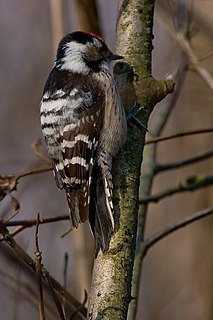
The lesser spotted woodpecker is a member of the woodpecker family Picidae. It was formerly assigned to the genus Dendrocopos. Some taxonomic authorities continue to list the species there.

Cobra is the common name of various elapid snakes, most of which belong to the genus Naja.

The Sphingidae are a family of moths (Lepidoptera) called sphinx moths, also colloquially known as hawk moths, with many of their caterpillars known as “hornworms”; it includes about 1,450 species. It is best represented in the tropics, but species are found in every region. They are moderate to large in size and are distinguished among moths for their agile and sustained flying ability, similar enough to that of hummingbirds as to be reliably mistaken for them. Their narrow wings and streamlined abdomens are adaptations for rapid flight. The family was named by French zoologist Pierre André Latreille in 1802.
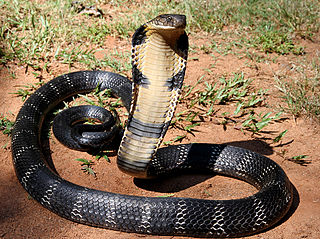
Elapidae is a family of venomous snakes characterized by their permanently erect fangs at the front of the mouth. Many members of this family are also recognized by their threat display of rearing upwards while spreading the neck-flap. Elapids are endemic to tropical and subtropical regions around the world, with terrestrial forms in Asia, Australia, Africa, and the Americas alongside marine forms in the Pacific and Indian Oceans. Members of the family have a wide range of sizes, from the 18 cm (7.1 in) white-lipped snake to the 5.85 m king cobra. Most species have neurotoxins in their venom which is channeled by their hollow fangs, while some may contain other toxic components in various proportions. The family includes 55 genera with some 360 species and over 170 subspecies.

Synaptomys is a genus of North American lemmings. These animals live in wet forested and open areas. They are small, cylindrical rodents with large heads and short ears, legs, and tails. They eat green vegetation such as grasses and sedges. They are often found in colonies.

The genus Eligmodontia consists of five or six species of South American sigmodontine mice restricted to Bolivia, Chile, and Argentina. Species of Eligmodontia occur along the eastern side of the Andes Mountains, in Patagonia, and in the Chaco thorn forest of South America. They can be found in arid and semiarid habitats and in both high and low elevation areas. These rodents are commonly known as gerbil mice or by their local name lauchas. Sometimes they are also called silky desert mice, highland desert mice or silky-footed mice. The closest living relatives are probably the chaco mice (Andalgalomys), the leaf-eared mice, and Salinomys.
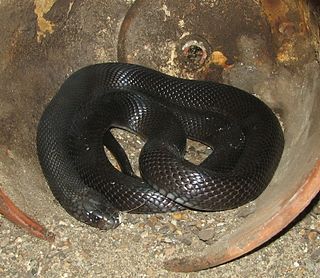
Walterinnesia aegyptia, also known as the desert cobra or desert black snake, is a species of venomous snakes in the family Elapidae that is native to the Middle East. The specific epithet aegyptia refers to part of its geographic range.

Walterinnesia is a genus of venomous snakes in the family Elapidae. The genus contains two species, known commonly as desert black snakes or black desert cobras, which are endemic to the Middle East. The generic name Walterinnesia honours Walter Francis Innes Bey (1858–1937), who was a physician and zoologist in Egypt.
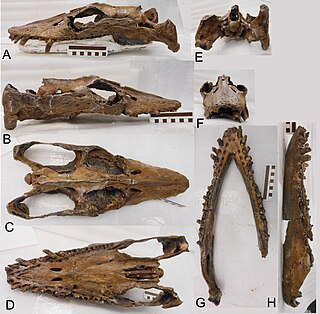
Libonectes is an extinct genus of sauropterygian reptile belonging to the plesiosaur order. It is known from specimens found in the Britton Formation of Texas (USA) and the Akrabou Formation of Morocco, which have been dated to the lower Turonian stage of the late Cretaceous period.
Morgan's gerbil mouse, also known as the western Patagonian laucha, is a South American species of rodent in the family Cricetidae. It is named for J. P. Morgan, one of the sponsors of the expedition that first identified the species.

Iranotherium was a genus of large elasmotheriine rhinoceros, comparable in size to a modern white rhino. It is known from the Late Miocene (Tortonian) of Maragha, Iran and the middle part of the Liushu formation of northwestern China. It was a precursor to the related Sinotherium and may have been ultimately outcompeted by its descendant. This species is most well known for showing unique sexual dimorphism among rhinos.
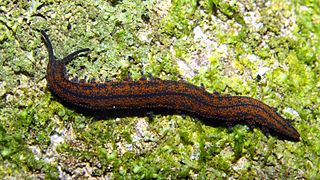
Peripatoides is a genus of velvet worms in the Peripatopsidae family. These animals are nocturnal hunters that spit glue to trap their prey. In New Zealand species of Peripatoides have 14, 15 or 16 pairs of legs. Female Peripatoides produce eggs that are fertilized internally and babies develop inside their mother until large enough to be born, in batches of 4-6, as colourless miniatures of the parents. These live-bearing Peripatoides have dermal-haemocoelic sperm transfer - which means sperm dissolve holes in the skin of the female to enter the body (haemolymph) anywhere on the body wall of the female.
Bailya morgani is a species of sea snail, a marine gastropod mollusk in the family Pisaniidae.

Bailya is a genus of sea snails, marine gastropod mollusks in the family Pisaniidae.
Andrew Price Morgan was an American botanist. He investigated the flora of the Miami Valley in Ohio. While his interest included flowering plants, as noted by his Flora of the Miami Valley, Ohio, his special interest was in fungi. Morgan worked as a teacher in Dayton. He studied the botany of the Great Miami River, publishing in 1878 the Flora of the Miami River, Ohio; Morgan also showed particular interest in mycology and bryology. A.P. Morgan was a mentor to the prominent American mycologist Curtis Gates Lloyd. His correspondence with Lloyd is stored in the Lloyd Library and Museum in Cincinnati. Lloyds portion of the correspondence is stored in the Ada Hayden Herbarium at Iowa state university. Morgans collection of preserved fungi can also be found at the Ada Hayden Herbarium along with Laura Morgans gouache illustrations of fungi that could not be preserved.
Black Desert may refer to:

Eratoneura morgani is a species of leafhopper in the family Cicadellidae.

Calcinus morgani, commonly known as Morgan's hermit crab, is a species of hermit crab in the family Diogenidae found in the Indo-West Pacific region, the type locality being Indonesia.













